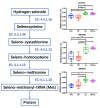Effects of Selenium- and Zinc-Enriched Lactobacillus plantarum SeZi on Antioxidant Capacities and Gut Microbiome in an ICR Mouse Model
- PMID: 33096847
- PMCID: PMC7589369
- DOI: 10.3390/antiox9101028
Effects of Selenium- and Zinc-Enriched Lactobacillus plantarum SeZi on Antioxidant Capacities and Gut Microbiome in an ICR Mouse Model
Abstract
Selenium and zinc are essential trace minerals for humans with various biological functions. In this study, selenium- and zinc-tolerant lactic acid bacteria (LAB) isolates were screened out from human fecal samples. Amongst three hundred LAB isolates, the Lactobacillus plantarum SeZi strain displayed the tolerance against selenium and zinc with the greatest biomass production and bioaccumulation of selenium and zinc. To further assess the characteristics of this strain, the lyophilized L. plantarum SeZi were prepared and administered to Institute of Cancer Research (ICR) mice. The mice were divided into four groups, provided with normal chow (Con), or normal chow supplemented with Na2SeO3 and ZnSO4∙7H2O (SZ), L. plantarum SeZi (Lp), or selenium- and zinc-enriched L. plantarum SeZi (SZ + Lp), respectively. After 4 weeks of oral administration, the concentrations of selenium and zinc in blood were significantly increased in the SZ + Lp group when compared to the control or SZ group (p < 0.05). The increased selenium level led to an enhanced glutathione peroxidase activity and decreased blood malondialdehyde level in the SZ + Lp group (p < 0.05). Meanwhile, the results of bacterial community and microbial metabolic pathway analysis via 16S rRNA gene amplicon sequencing showed that L. plantarum SeZi significantly promoted the utilization of selenocysteine, seleno-cystathionine and seleno-methionine in the selenocompounds metabolism. Here, the in vivo antioxidant capacities of the selenium- and zinc-enriched lactobacillus strain showed us the utilization of a unique probiotic as a Se/Zn supplement with high availability, low toxicity, and additional probiotic advantages.
Keywords: antioxidant capacities; bioaccumulation; gut microbiota; selenium; zinc.
Conflict of interest statement
G.E.J. holds BIFIDO Ltd. stocks. Other authors declare no conflict of interest.
Figures






Similar articles
-
Effects of exposure to cadmium (Cd) and selenium-enriched Lactobacillus plantarum in Luciobarbus capito: Bioaccumulation, antioxidant responses and intestinal microflora.Comp Biochem Physiol C Toxicol Pharmacol. 2022 Jul;257:109352. doi: 10.1016/j.cbpc.2022.109352. Epub 2022 Apr 20. Comp Biochem Physiol C Toxicol Pharmacol. 2022. PMID: 35460911
-
Sustainable microbial cell nanofactory for zinc oxide nanoparticles production by zinc-tolerant probiotic Lactobacillus plantarum strain TA4.Microb Cell Fact. 2020 Jan 15;19(1):10. doi: 10.1186/s12934-020-1279-6. Microb Cell Fact. 2020. PMID: 31941498 Free PMC article.
-
Selenium and zinc internalized by Lactobacillus buchneri Lb26 (DSM 16341) and Bifidobacterium lactis Bb1 (DSM 17850): improved bioavailability using a new biological approach.J Clin Gastroenterol. 2012 Oct;46 Suppl:S41-5. doi: 10.1097/MCG.0b013e318268861d. J Clin Gastroenterol. 2012. PMID: 22955356
-
Effect of selenium supplements on the antioxidant activity and nitrite degradation of lactic acid bacteria.World J Microbiol Biotechnol. 2019 Mar 27;35(4):61. doi: 10.1007/s11274-019-2609-x. World J Microbiol Biotechnol. 2019. PMID: 30919142
-
Preparation of selenium/zinc-enriched probiotics and their effect on blood selenium and zinc concentrations, antioxidant capacities, and intestinal microflora in canine.Biol Trace Elem Res. 2011 Jun;141(1-3):170-83. doi: 10.1007/s12011-010-8734-x. Epub 2010 Jun 19. Biol Trace Elem Res. 2011. PMID: 20563665 Clinical Trial.
Cited by
-
Mineral-Enriched Postbiotics: A New Perspective for Microbial Therapy to Prevent and Treat Gut Dysbiosis.Biomedicines. 2022 Sep 25;10(10):2392. doi: 10.3390/biomedicines10102392. Biomedicines. 2022. PMID: 36289654 Free PMC article. Review.
-
Selenium Nanoparticle-Enriched and Potential Probiotic, Lactiplantibacillus plantarum S14 Strain, a Diet Supplement Beneficial for Rainbow Trout.Biology (Basel). 2022 Oct 18;11(10):1523. doi: 10.3390/biology11101523. Biology (Basel). 2022. PMID: 36290428 Free PMC article.
-
Review on the health-promoting effect of adequate selenium status.Front Nutr. 2023 Mar 16;10:1136458. doi: 10.3389/fnut.2023.1136458. eCollection 2023. Front Nutr. 2023. PMID: 37006921 Free PMC article. Review.
-
Effect of Organic Selenium on the Homeostasis of Trace Elements, Lipid Peroxidation, and mRNA Expression of Antioxidant Proteins in Mouse Organs.Int J Mol Sci. 2023 Jun 2;24(11):9704. doi: 10.3390/ijms24119704. Int J Mol Sci. 2023. PMID: 37298655 Free PMC article.
-
Skin Minerals: Key Roles of Inorganic Elements in Skin Physiological Functions.Int J Mol Sci. 2022 Jun 3;23(11):6267. doi: 10.3390/ijms23116267. Int J Mol Sci. 2022. PMID: 35682946 Free PMC article. Review.
References
-
- Rayman M.P. Selenium. Springer; New York, NY, USA: 2011. Selenium and adverse health conditions of human pregnancy; pp. 531–544.
Grants and funding
LinkOut - more resources
Full Text Sources
Miscellaneous

